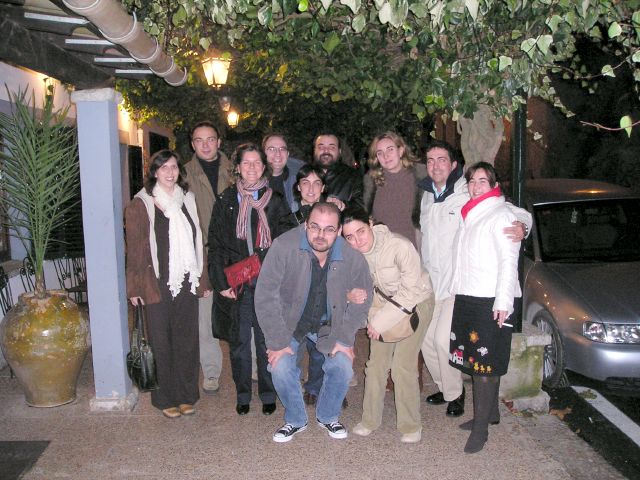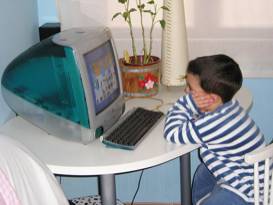John McCarthy, el que va encunyar el terme “intel·ligència artificial” fa servir Mac (sembla un TiBook no?)
La foto és de la “Última Hora” d’avui

Blog personal
John McCarthy, el que va encunyar el terme “intel·ligència artificial” fa servir Mac (sembla un TiBook no?)
La foto és de la “Última Hora” d’avui

Ahir vàrem celebrar que fa 10 anys que anam a dinar a Orient. La festa va ser tan memorable que vaig obrir una web a posta … http://orient.codoler.net
“Parque Infantil de Navidad” (PIN). Així es deia la “cosa” a la que vàrem anar ahir. Jo no sé qui ho pagava però del que estic segur és que el “parque” (tot en “perfecto castellano”) l’han muntat a cop de talonari. Almanco no es notava la feina de cap tècnic pensant quins jocs serien els millors pels infants.
Suposadament, els infants s’han de passar unes hores jugant a les atraccions muntades al recinte IFEBAL. Però el que jo he vist han estat les cares llargues dels pares cansats de fer cua carregats amb els abrics dels seus infants, les cares de fàstic dels monitors, probablement mal pagats, cansats de fer sempre el mateix, i les cares dels infants primer d’il·lusió abans de pujar a l’atracció i després de decepció quan s’acabaven els quatre o cinc minuts que durava. Continua llegint «PIN»

Previous research has shown that phobic subjects with low heart rate variability (HRV) are less able to inhibit an inappropriate response when confronted with threatening words compared to phobic subjects with high HRV [Johnsen, B.H., Thayer, J.F., Laberg, J.C., Wormnes, B., Raadal, M., Skaret, E., et al., 2003. Attentional and physiological characteristics of patients with dental anxiety. Journal of Anxiety Disorders, 17, 75-87]. The aim of this study was to evaluate changes in self-reported anxiety when low HRV and high HRV fearful flyers (N = 15) and a matched control group (N = 15) were exposed to flight-related pictures, flight-related sounds or both pictures and sounds. We hypothesized that sounds would be crucial to evoke fear. Also, low HRV fearful flyers were expected to report higher anxiety than high HRV fearful flyers assuming anxiety as their inappropriate response. Decreases on HRV measures were also predicted for a subgroup of phobic participants (N = 10) when confronted with the feared stimuli. Our data supported the hypothesis that sounds are crucial in this kind of phobia. Low HRV fearful flyers reported higher anxiety than high HRV fearful flyers in two out of three aversive conditions. The predicted HRV decreases were not found in this study. Results are discussed in the context of avoidance of exposure-based treatments.
I l’any que ve farà 10 anys que cada any ens fotem una o dues porcelles a Orient … seguirem informant.

En Juan de Dios Santander Vela sol posar cites després de la signatura dels seus correus. Avui n’ha posat una que m’ha agradat molt …
Voltaire: La medicina consiste en distraer al enfermo mientras la naturaleza cura la enfermedad.
Des d’aquí vull recomanar la visita regular al seu bloc: ‘memoria de acceso aleatorio‘
Ja estic intentant aficar el “cuquet” del mac en els meus fills. Vosaltres direu, manipulació! Idò sí. Educar és això, no?


Chaos theory provides a new way to analyze the psychophysiological functioning of anxiety disordered people. However, in order to apply any of the nonlinear analysis techniques, nonlinearity tests must be performed and nonlinearity must be found in the psychophysiological signal. In this experimental study we use the surrogate data method to analyze the nonlinearity of the ECG time series of students with and without fear of flying under several stressing conditions. The prediction errors of the surrogate data were found to be much higher than the prediction errors of the ECG signals (p < .05) in all the experimental conditions as well as during the baseline period. We conclude that nonlinear properties are in fact in the ECGs of the participants, and therefore it would be possible to analyze these signals with nonlinear techniques to get knowledge about their comnplexity, entropy, regularity, and so on.
In the present study, the relationship between self-implication during simulated exposure to feared stimuli and Heart Rate Variability (HRV) was explored within the framework of the dynamical systems model of emotion regulation proposed by Thayer and Lane (Thayer, J.F., and Lane, R.D. (2000). A model of neurovisceral integration in emotion regulation and dysregulation. Journal of Affective Disorders, 61, 201–216.). An analogue sample of flight phobics (n=15) and a matched non-phobic control group (n=15) were presented with flight-related pictures, flight-related sounds or flight-related pictures and sounds. Significant differences on self-implication during exposure to flight-related sounds were found between low and high HRV fearful flyers, the former being more self-implied. However, the expected HRV decreases in the phobic participants exposed to feared stimuli were not found. These results emphasize the need to distinguish between high and low HRV fearful flyers in order to make a better use of the simulated exposure treatments.